I’ve been looking at teams from a high level strategy perspective in my Roster Ruminations series of posts. It’s been interesting to see how the entirety of a team’s transactions sometime uncover different insights than looking at each transaction on it’s own and to consider how each team might approach the future. Let’s take it a step further now and build a roadmap for how a team might strategize to build and maintain a sustainably competitive roster using cohort theory.
The Calgary Flames are the most recent team I looked at in a Roster Ruminations post. Their status as a team that’s well into a significant roster overhaul that has yet to look anything like a finished product makes them an interesting case study for building a long term roadmap. It leaves us plenty of flexibility to shape the roster towards an end goal without too many other factors like the salary cap or short term contention ambitions getting in the way.
Player Tiers and Cohort Theory
If you’ve been following the blog for a while, you’ll be familiar with Player Tiers and Cohort Theory. They’re going to be key concepts for this discussion, so let’s do a quick refresher before we get further in.
Player Tiers
I defined a set of Player Tiers when I built the development profile distributions for draft picks. The intent was to identify where a player might reasonably fit in an average NHL roster based on their 5v5 ice time and 5v5 point production. The result gives us a starting point to consider where a player fits in a roster now and, with the development profiles added, where they might reasonably be expected to fit years down the road.
| Forward Tier | Criteria (5v5) | Approximate Depth Chart Rank |
| Elite | >75th percentile TOI/GP and >90th percentile P/60 | 1 |
| Support | >50th percentile TOI/GP and >75th percentile P/60 | 2-3 |
| Contributor | >25th percentile TOI/GP and >50th percentile P/60 | 4-7 |
| Depth | >25th percentile TOI/GP and >25th percentile P/60 | 8-10 |
| Replacement | All others | 11+ |
| Defenseman Tier | Criteria (5v5) | Approximate Depth Chart Rank |
| Elite | >75th percentile TOI/GP and >90th percentile P/60 | 1 |
| Support | >50th percentile TOI/GP and >50th percentile P/60 | 2-3 |
| Contributor | >25th percentile TOI/GP and >25th percentile P/60 | 4-5 |
| Replacement | All others | 6+ |
Of course, the depth chart ranks in the tables above are a guideline for an average NHL roster. If we want to build a contender, we need to put together a roster that is better than than. The goal in building a contender is to find an extra player or two at each tier to push the roster above average. Additions at the top are the ideal, since they push everyone else down the depth chart into more advantageous positions.
Cohort Theory
Cohort Theory was born of a desire to find a roster building strategy that could provide a method of maintaining a team’s competitiveness indefinitely. The boom/bust nature of the rebuild has become the prevailing expectation but inherent in it is the necessity to be very bad for long stretches. Cohort theory was meant to break out of that boom/bust cycle, have a lower bottom and longer truly competitive stretches.
The key to Cohort Theory is managing the age of the roster by grouping players into cohorts. Cohorts should be players in a tight age group, roughly 4 years. By focusing on building alternating cohorts, a team can create waves of talented players coming through their system that can naturally transition to keep a team competitive. Roster turnover is a big part of the theory, where players in their late prime need to be turned over to regenerate the roster and create open roster slots for the incoming cohort.
Calgary Flames Cohort Contention Roadmap
Now we’re ready to tackle our main objective: creating a roadmap for the Calgary Flames to build a sustainably competitive roster based in cohort theory. So, where do we start?
The first step is to recognize where the current roster is and whether it is at or near a contending level. I don’t think I’ll get too many arguments if I simply state the Flames roster is not there now. Their front office has acknowledged it as well with the moves they’ve made over the past 18 months, moving on from much of their 2022 playoff roster and adding future assets.
If we look at the player tiers based on the 2023-2024 season, we quickly confirm that the flames roster simply doesn’t stack up against even the average roster. There were 28 forwards that met the criteria for the Elite Forward tier. None were Flames. Mackenzie Weegar was the lone Flame that made the Elite Defenseman tier. Weegar just squeaked into the Elite tier at that, with the 18th ranked P/60 and 16th ranked TOI/GP of the 18 defensemen in the group.
The roster needs to be improved starting right from the top. We want to do it using a cohort of players that will grow and hit their prime together, ideally with 6 forwards and 3 defensemen included in it. We’ll take a little more leeway with goalies since there are only two roster slots. The best prospects in the Flames system originate from the 2023 and 2024 drafts and they have a lot of picks stockpiled for the 2025 and 2026 drafts. That’s our target cohort: the 2023-2026 draft years.
Primary Contention Cohort
With two drafts complete from our target window for our primary cohort, we have a number of prospects already in the Flames system to start planning around. Eventually, our target is to have 6 forwards and 3 defensemen in this group that are in Contributor tier or above. Of course, we need this group to help fill out the Elite and Support tiers as well so the entire group can’t top out as Contributors.
2023 & 2024 Drafted Prospects
Looking at the prospects the Flames have in their system, we can start to put together some likely candidates to be part of our primary cohort. Zayne Parekh, Hunter Brzustewicz and Henry Mews are the best bets for Defensemen. If we use Hockey Prospecting‘s NHLer probabilities, there is a 30% chance that they all play 200 games in the NHL and just a 2% chance that none of them do. If we’re lucky, we have our three defensemen already in the system and, if we’re unlucky, we probably still have at least one. Of course, they aren’t the only defensemen in the system from the 2023 and 2024 drafts so the hope is that if one of the top prospects doesn’t pan out, a more longshot prospect will instead.
The forward group is less well stocked if you consider that we want six forwards in our cohort. There are only four in the Flames system that Hockey Prospecting has at greater than 50% chance to become an NHLer: Andrew Basha, Luke Misa, Matvei Gridin, and Samuel Honzek. Using the same logic as above, there’s just a 10% chance that all four will make the NHLer criteria of 200 GP and there is a 3% chance that none of them do.
2025 & 2026 Draft Priorities
The Flames system is better stocked with defense prospects in our target cohort than it is for forwards. Adding another good defense prospect would help mitigate the risk that one or two of the three key prospects already in the system don’t pan out. Forwards should be the bigger focus though. The Flames system needs more volume of forward prospects and more top end forward prospects to ensure that enough pan out as NHL players, including the Elite and Support tier talent we need to build around.
Taking the best player available will always be a good draft strategy. If there’s a choice between a forward and a defenseman, though, the Flames would be wise to take the forward based on organizational need. They can also focus on adding forward prospects from the 2023 and 2024 draft classes in trades to help fill the need.
The development of their prospects will have to monitored and we’ll keep the option open to swap prospects in and out of the group if their outlook starts to change. This is the group we’re building around though, with the prospects currently most likely to fill out the cohort shown.
| F – Andrew Basha | F – Samuel Honzek | D – Zayne Parekh |
| F – Luke Misa | F – 2025 1st RD Pick | D – Hunter Brzustewicz |
| F – Matvei Gridin | F – 2026 1st RD Pick | D – Henry Mews |
Current NHL Roster
We’ve gotten this far with the plan back to contention without looking at a single roster player. That’s because the leading edge of our primary cohort is still five or six years from hitting their prime, so that defines our timeline for the push back to contention. Starting to challenge for a playoff spot in 4-5 years would be great, with a true contention window opening in 6-8 years. (Note: The Florida Panthers just won the 2024 Stanley Cup with a roster built around the 2013-2016 drafts, if we’re looking for a comparable to confirm our timeline is realistic. That’s a championship 11 years after the earliest draft in the contention cohort.)
With half the NHL lineup expected to be filled out by the primary cohort, we still have half a lineup to fill out. We want half of that to come from the next developing cohort of younger players (think 2031 draft class) and the other half to be veteran players that may already be on the roster.
| Huberdeau | Backlund | Coleman | Weegar | Andersson |
| Mantha | Kadri | Kuzmenko | Bahl | Miromanov |
| Pospisil | Zary | Sharangovich | Bean | Pachal |
| Lomberg | Rooney | Coronato | Wolf | Vladar |
Let’s now go through the current NHL roster, first identifying the players that may be long term fits for our contention plan. Then, we’ll look for others that may be valuable trade chips at opportune times to turn over the rest of the roster. That will help to recoup younger assets in our attempt to make the newly competitive roster sustainable. Players are listed below with the following information: Position – Player (Age / Cap Hit / Years Remaining Under Contract).
Veteran Cohort
We’re looking for 3 forwards and 1 or 2 defensemen as long term pieces for our contention roster. We also need to find a starting goaltender at some point, so we can add that if we think we have a suitable piece. Let’s take a look at our best options:
F – Connor Zary (22 / $863k / 1Y): Zary had a fantastic rookie season. He played a significant role last season and produced at a level that made him one of the most effective late first round picks for his D+4 season. He’s a bit older than our target cohort, but only by a couple of years. He’s tracking to be a good Support tier player in his prime and he’ll be in his mid prime when the target window opens. We’ll have to watch for a sophomore slump this season to confirm if his rookie season might be leading our projection astray.
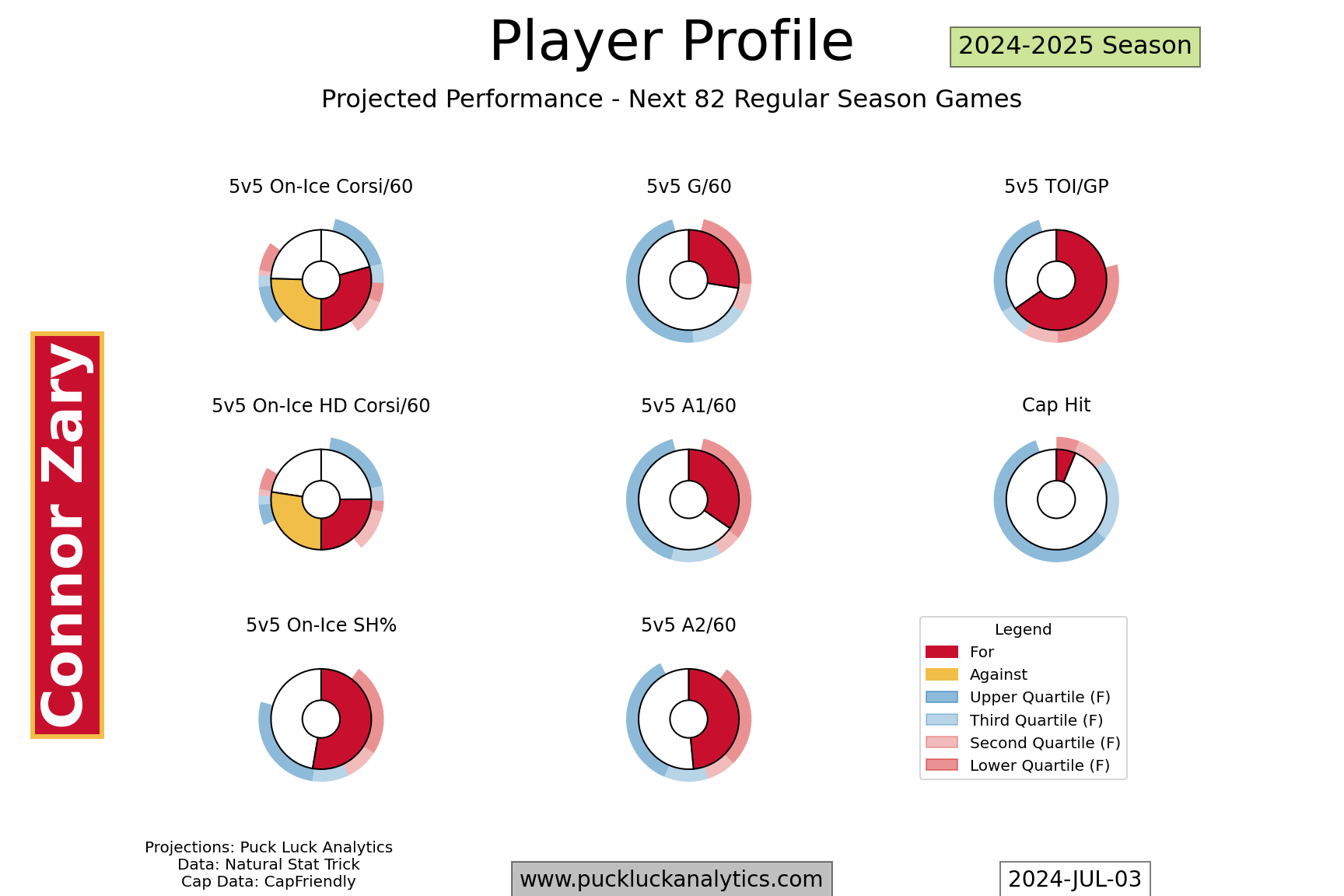
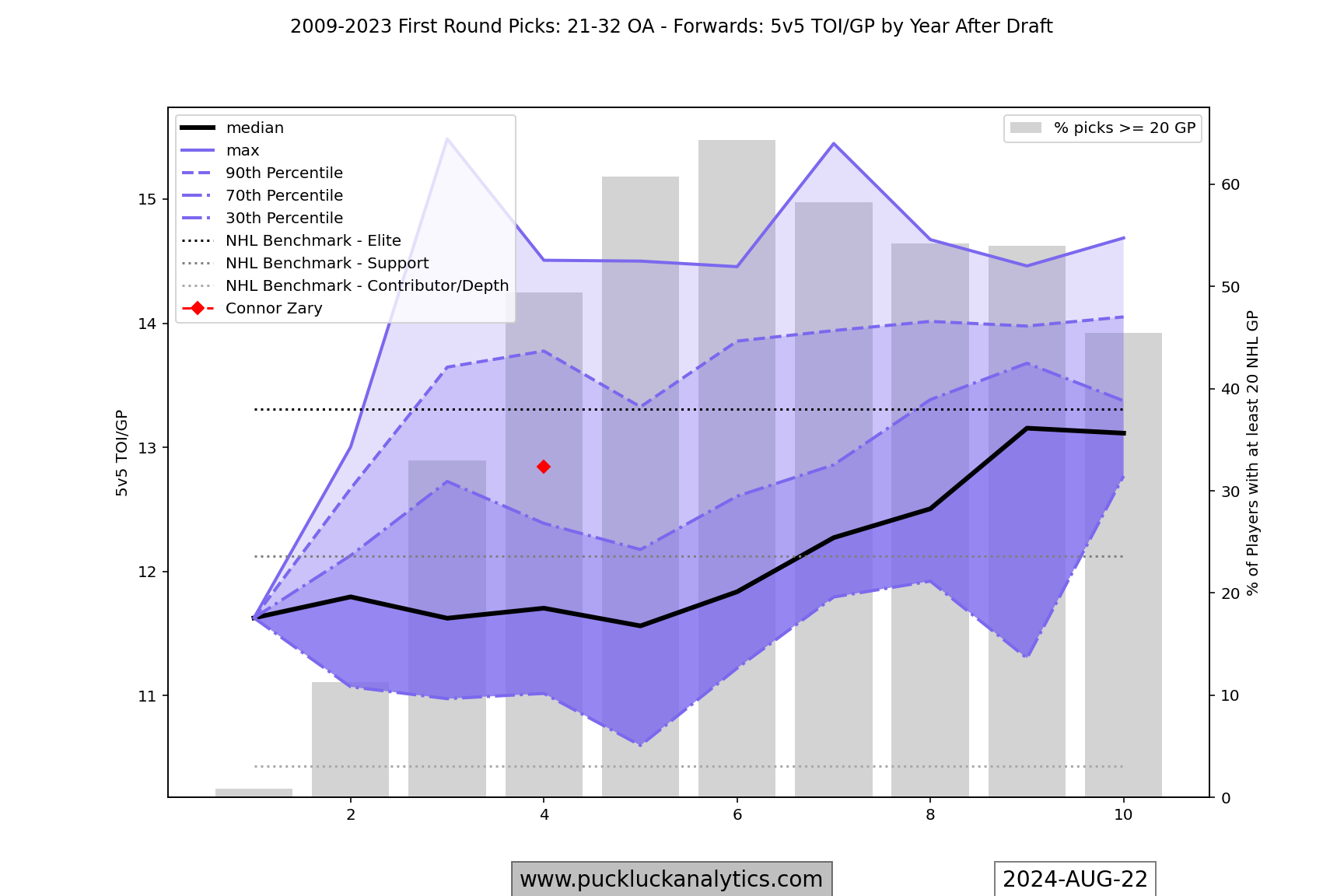
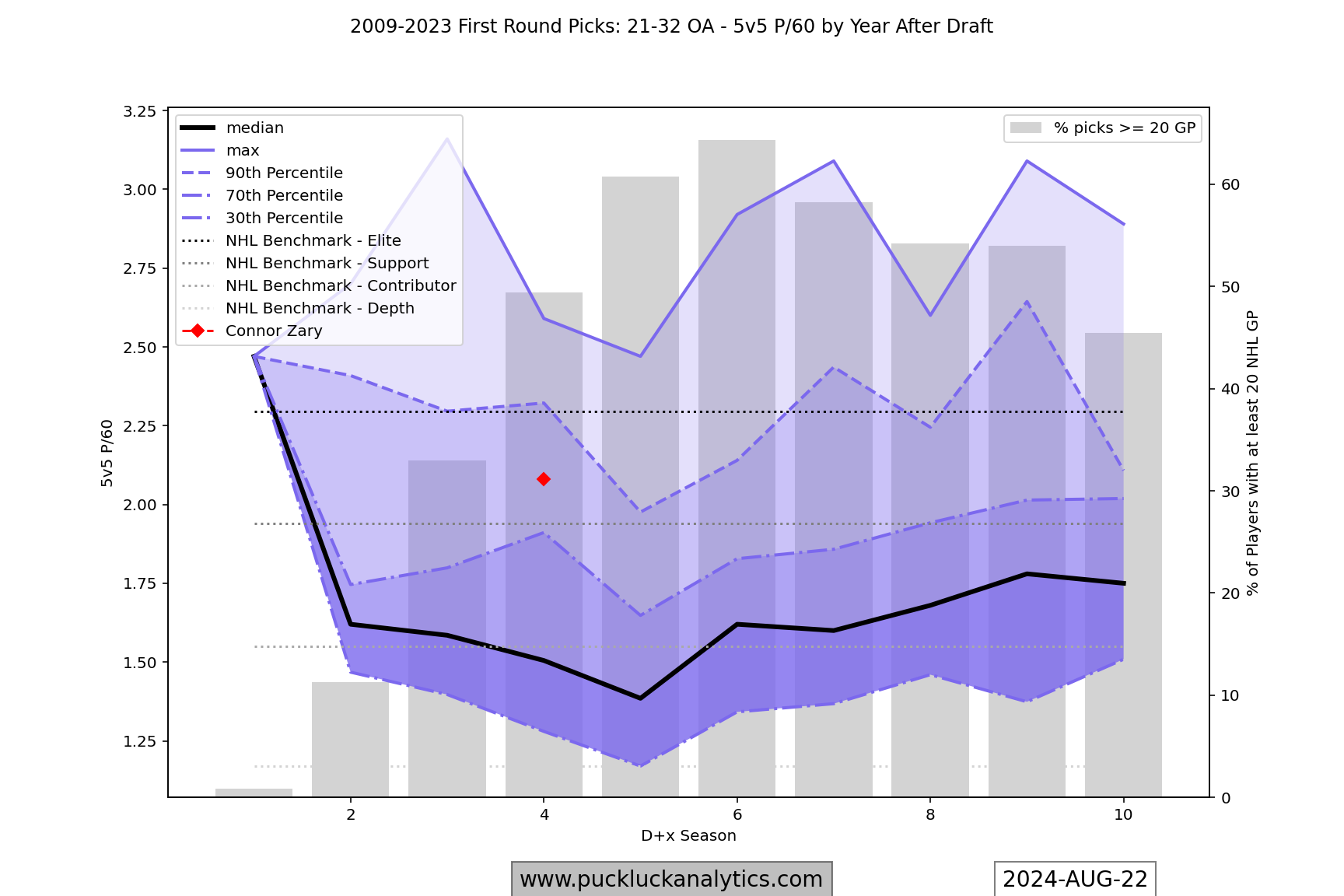
F – Yegor Sharangovich (26 / $3.1M–>$5.75M / 6Y): Sharangovich excelled in his first year with the Flames, earning him a five year contract extension that will kick in for the 2025-2026 season. He’s tracking well relative to other fifth round picks that make the NHL and he fell in the Contributor Tier last season. He can hold down a top six roster spot while the contention roster takes shape and, if he continues to track near the 70th percentile for fifth round picks, we can expect him to be a Contributor Tier forward for the contention roster.
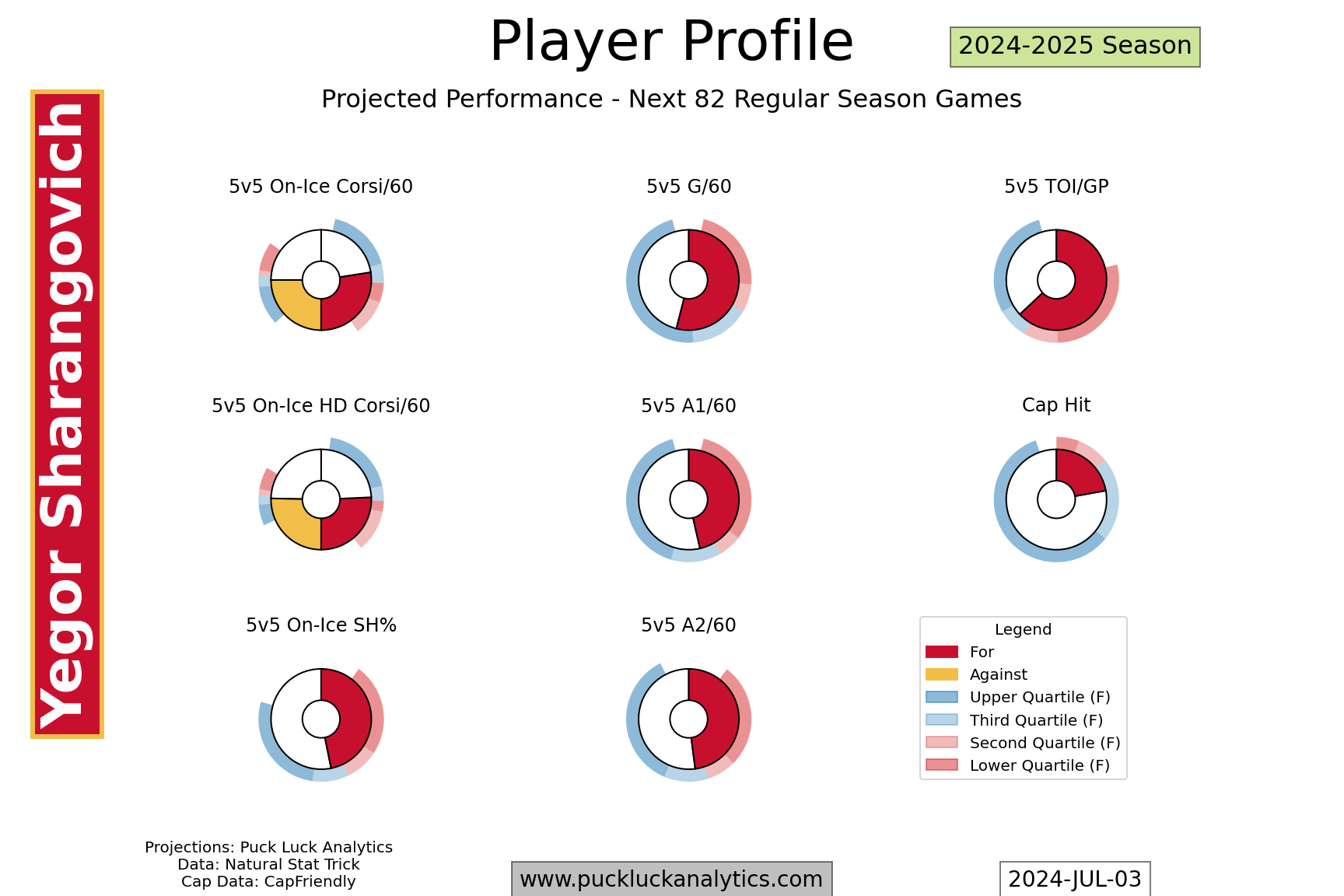

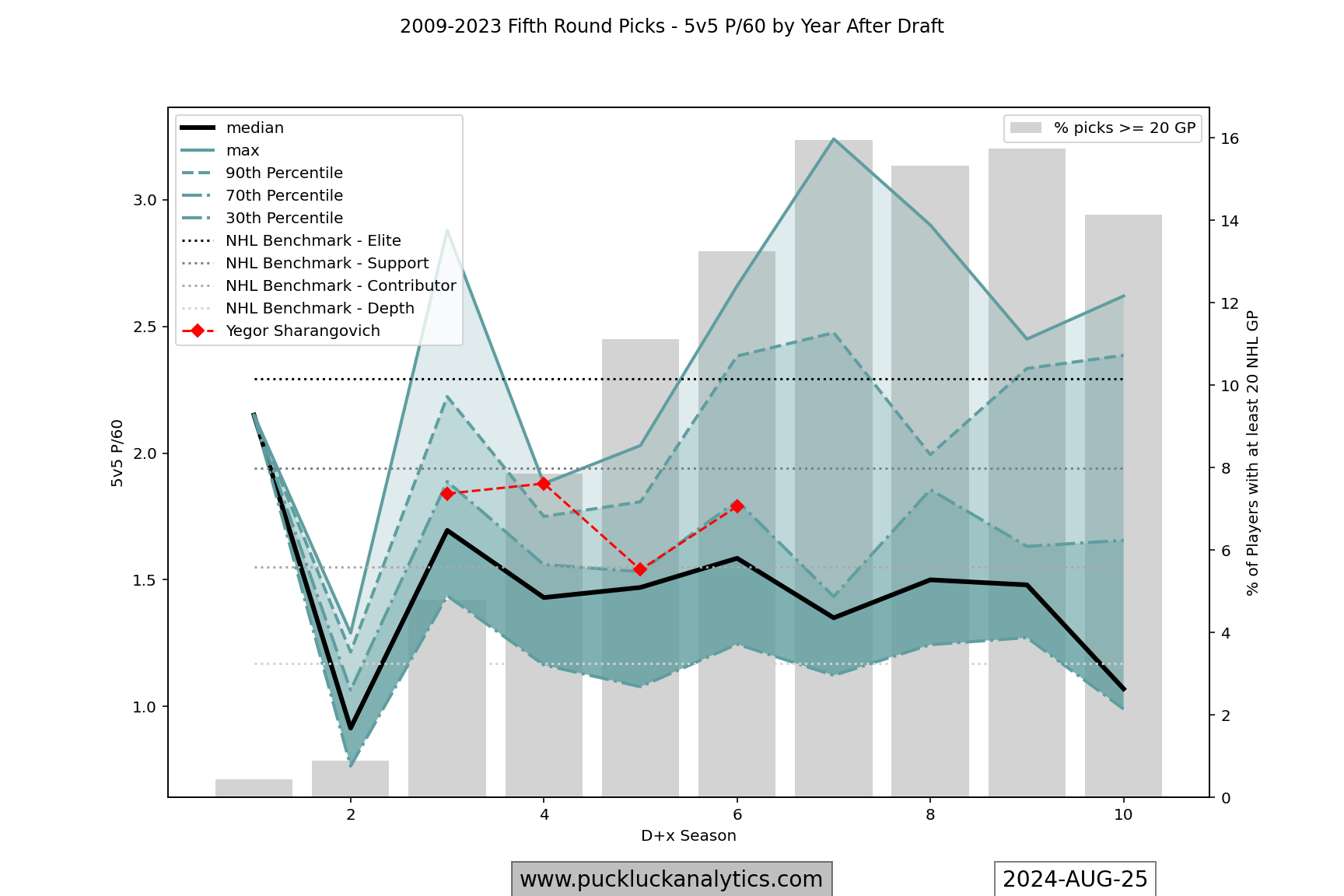
F – Martin Pospisil (24 / $1.0M / 2Y): Pospisil quickly became a fan favorite in his rookie season. The fourth round pick burst into NHL with his high energy game and he’s just entering his prime. Based on the typical fourth round pick development profile, we should expect him to be a Contributor Tier forward in our long term plan. At age 24, there isn’t much development runway left though so if his performance drops in the 2024-2025 season we may need to look for another option.
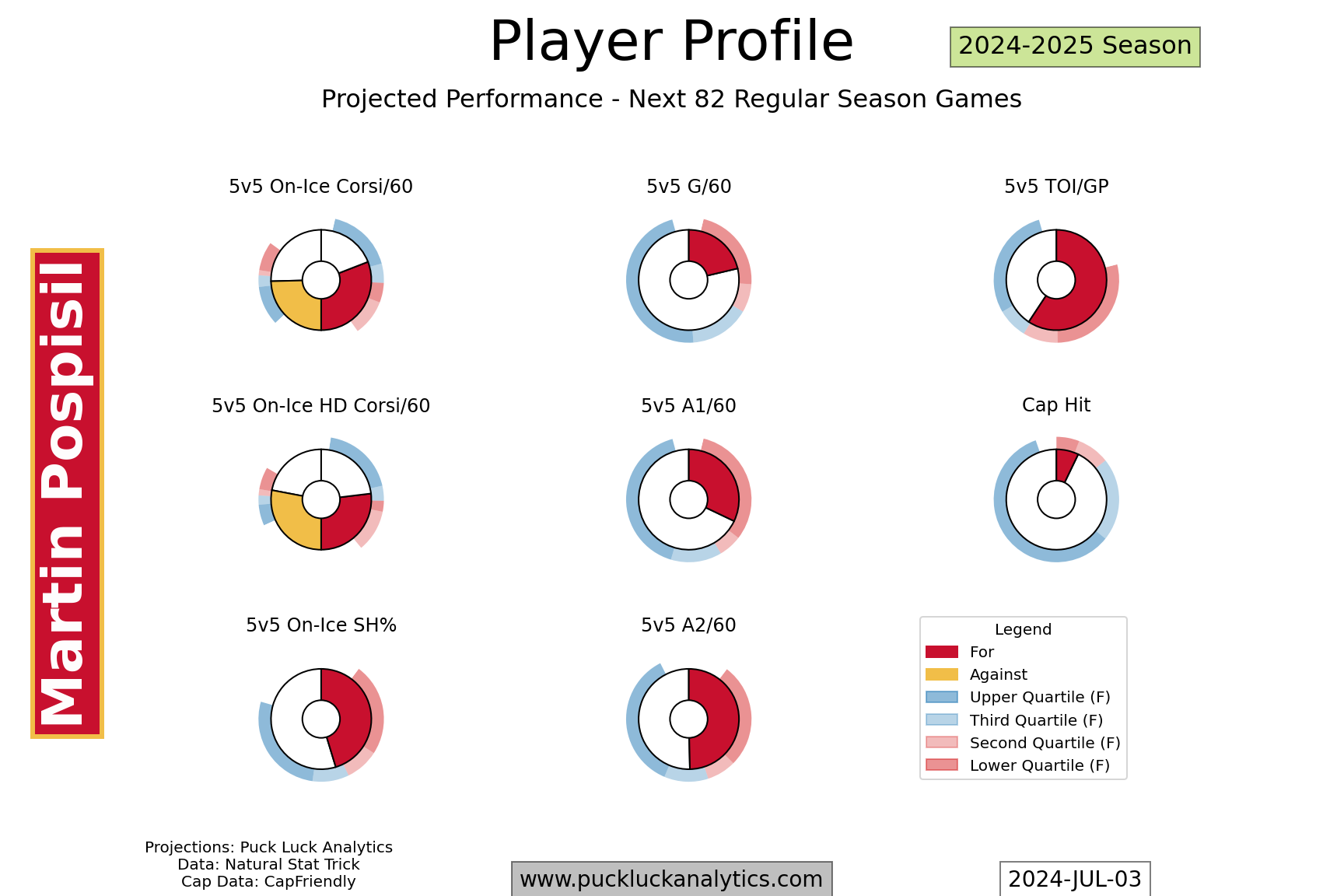
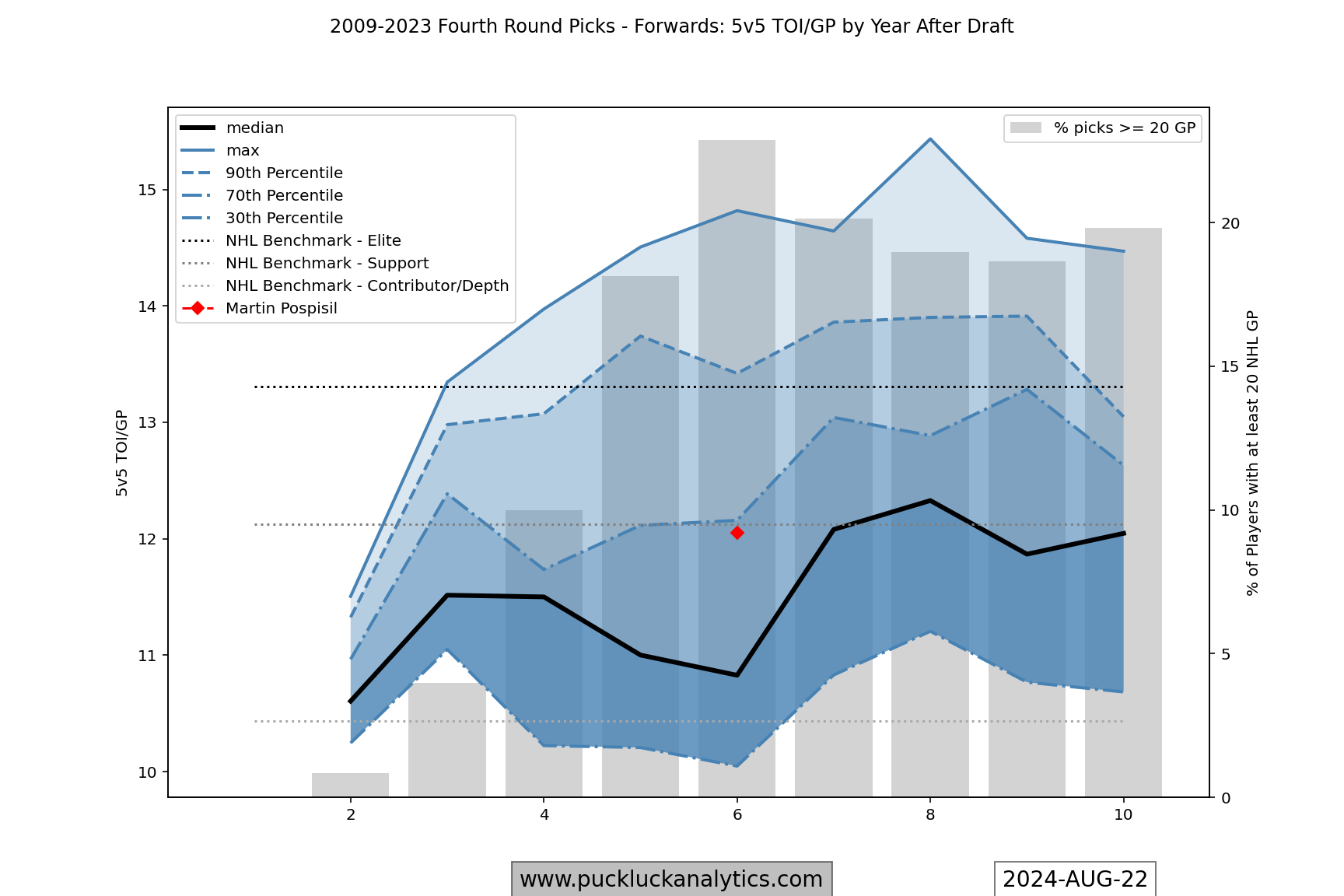
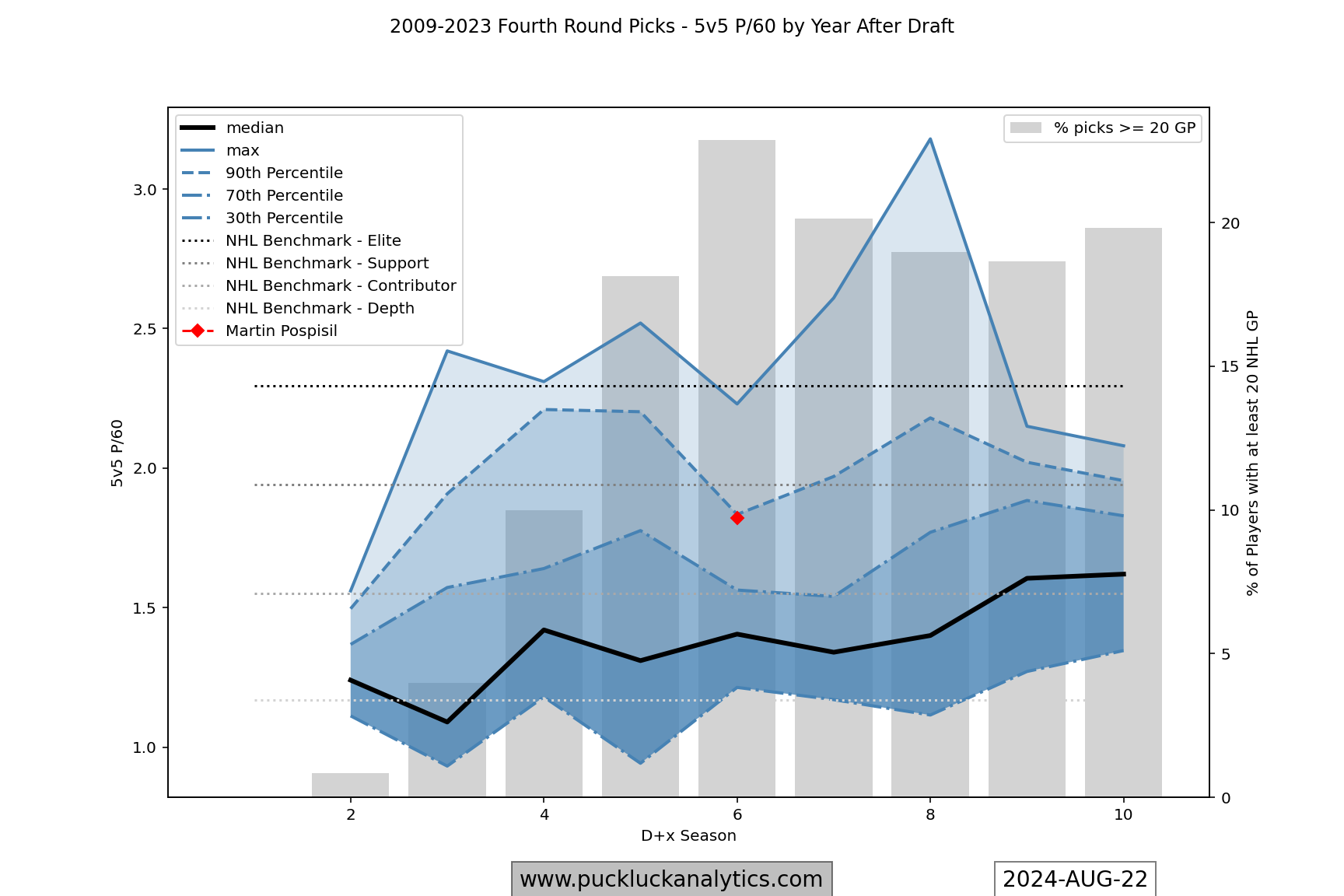
D – Mackenzie Weegar (30 / $6.25M / 7Y): Part of the Flames 2022 blockbuster deal with the Panthers, Weegar has settled in on the Flames blue line. He still has seven years on his deal, which could see him on the roster until the target contention window opens. As we noted earlier, he just squeaked into the Elite Tier last season and he’ll be a steadying veteran presence that can mentor the primary contention cohort as they enter the NHL. He’ll be in his mid-late 30s by the time we want the roster to be competitive though, so a Support or Contributor Tier role then should be our expectation.
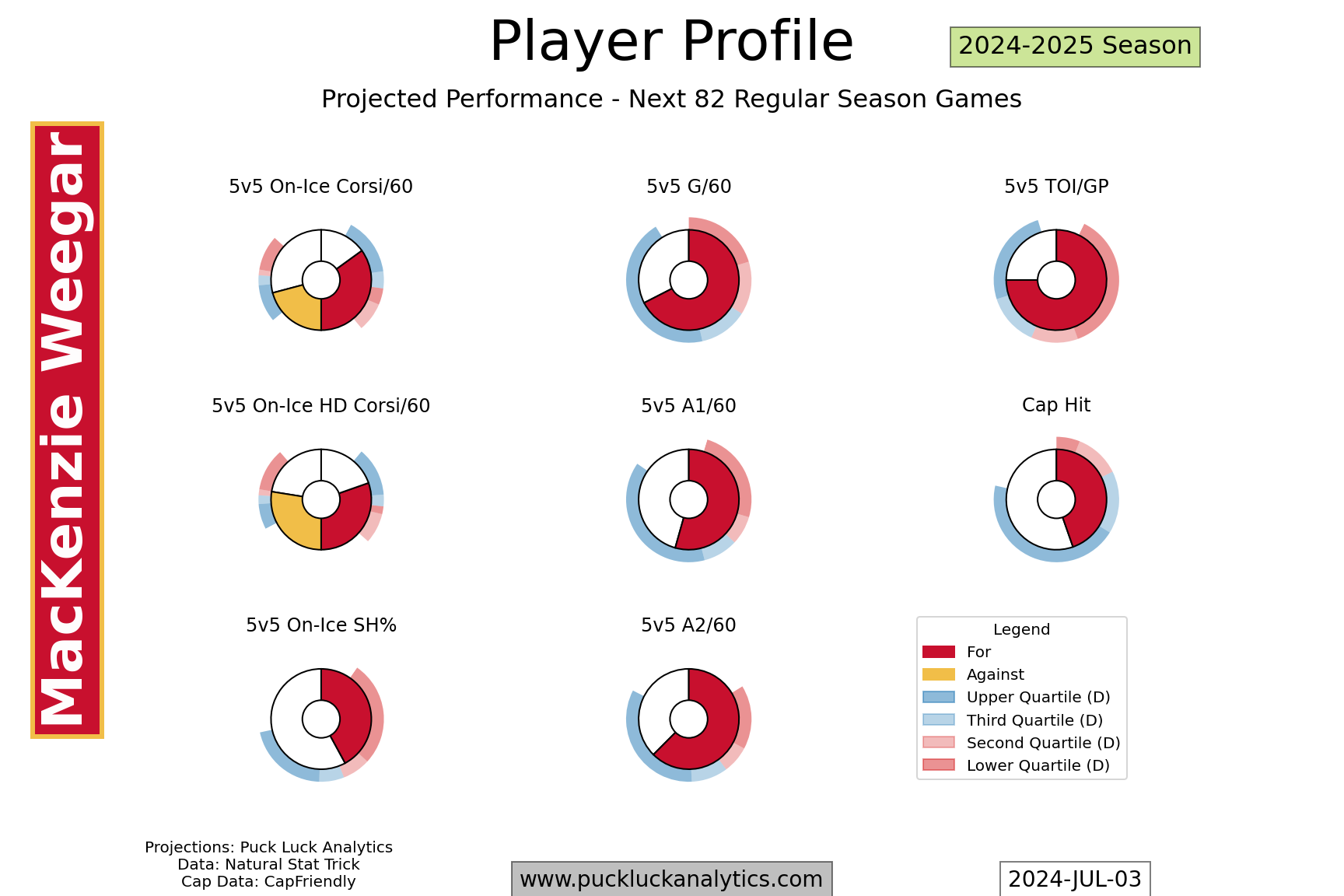
G – Dustin Wolf (23 / $850k / 2Y): The door is open for Wolf to earn some NHL starts after the Flames sent Jacob Markstrom to the Devils this offseason. The Flames need a goalie for the future and seeing Wolf in more NHL action will help convince the team his game will translate to the NHL level. We need a starting goaltender for the contention roster and Wolf looks like a reasonable bet right now.
With the veteran cohort added to our primary contention cohort, here’s what we expect the roster to look like when it’s ready to contend. TBD is used to identify the spots that we still need to fill. We’ll consider all options to find a suitable player, but the ideal scenario is finding players from our future cohort to start working into the NHL roster.
| Andrew Basha (Support) | 2025 1st RD Pick (Elite) | 2026 1st RD Pick (Elite) | TBD | Zayne Parekh (Elite) |
| Sam Honzek (Contributor) | Zary (Support) | Matvei Gridin (Support) | Weegar (Contributor) | Hunter Brzustewicz (Support) |
| Pospisil (Contributor) | Luke Misa (Contributor | Sharangovich (Contributor) | TBD | Henry Mews (Contributor) |
| TBD | TBD | TBD | Wolf (Starter) | TBD |
Trade Bait
With the veteran cohort identified, the rest of the roster becomes expendable in our long term plan. We’ll want to avoid flooding the trade market with similar players and we need to continue to fill out an NHL roster while the primary cohort is still developing in lower levels, so we’ll want to stagger our target trade windows.
F – Andrei Kuzmenko (28 / $5.5M / 1Y): Kuzmenko has put up points at a strong clip throughout his short NHL career, including a strong finish to the 2023-2024 season after the trade from Vancouver to Calgary. In his late prime and in the last year of his contract, he’s a prime candidate to feature in a big role this season and trade to a contender before this year’s trade deadline.
F – Anthony Mantha (29 / $3.5M / 1Y): Mantha signed in Calgary for a single season this summer. At a reasonable $3.5M cap hit, he’s another prime candidate to be trade bait for a contender at the 2025 season.
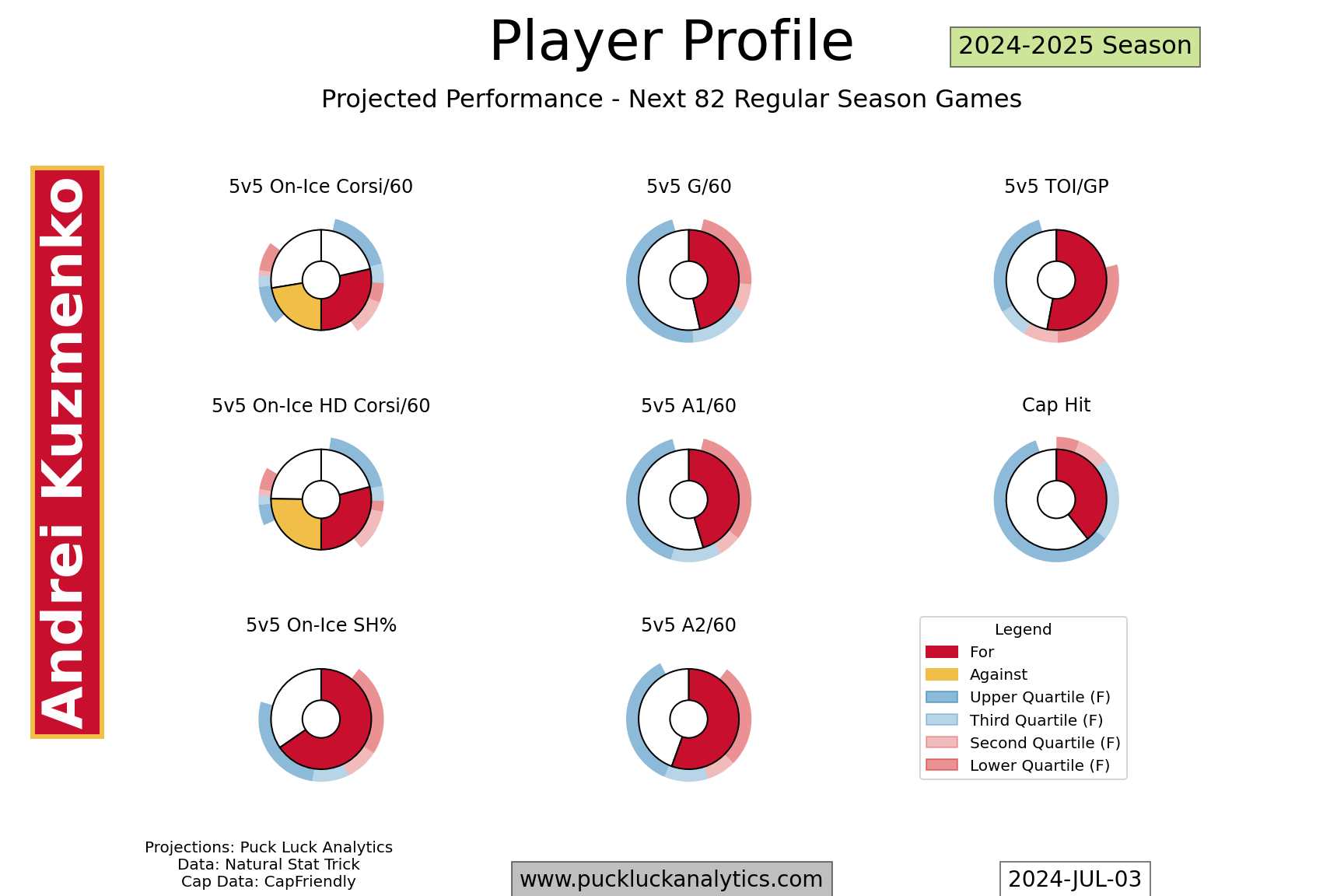
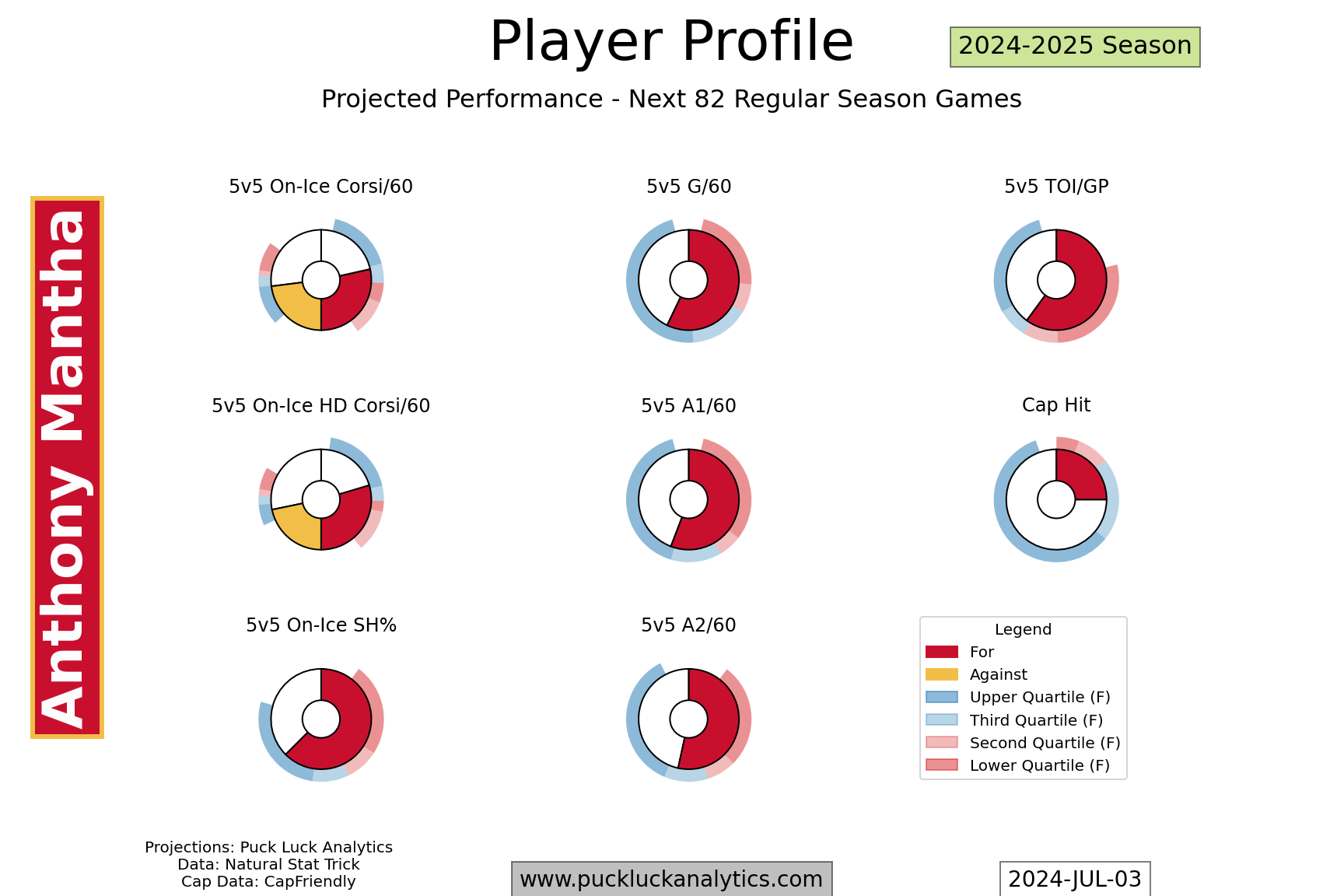
F – Matt Coronato (21 / $925k / 1Y): Matt Coronato has been nipping at the NHL for the past couple of seasons. The 2021 13th overall pick has yet to solidify his place on the Flames roster but he’ll likely get opportunity to do so this season. He’s worth consideration for a long term role but he doesn’t make the cut for the veteran cohort right now. In his first season with more than 20 NHL games, he didn’t show well relative to other forwards selected in the mid first round. He’ll be an RFA next summer and if he doesn’t have a big jump in production this season, capitalizing on his draft pedigree for a trade might be the best option.
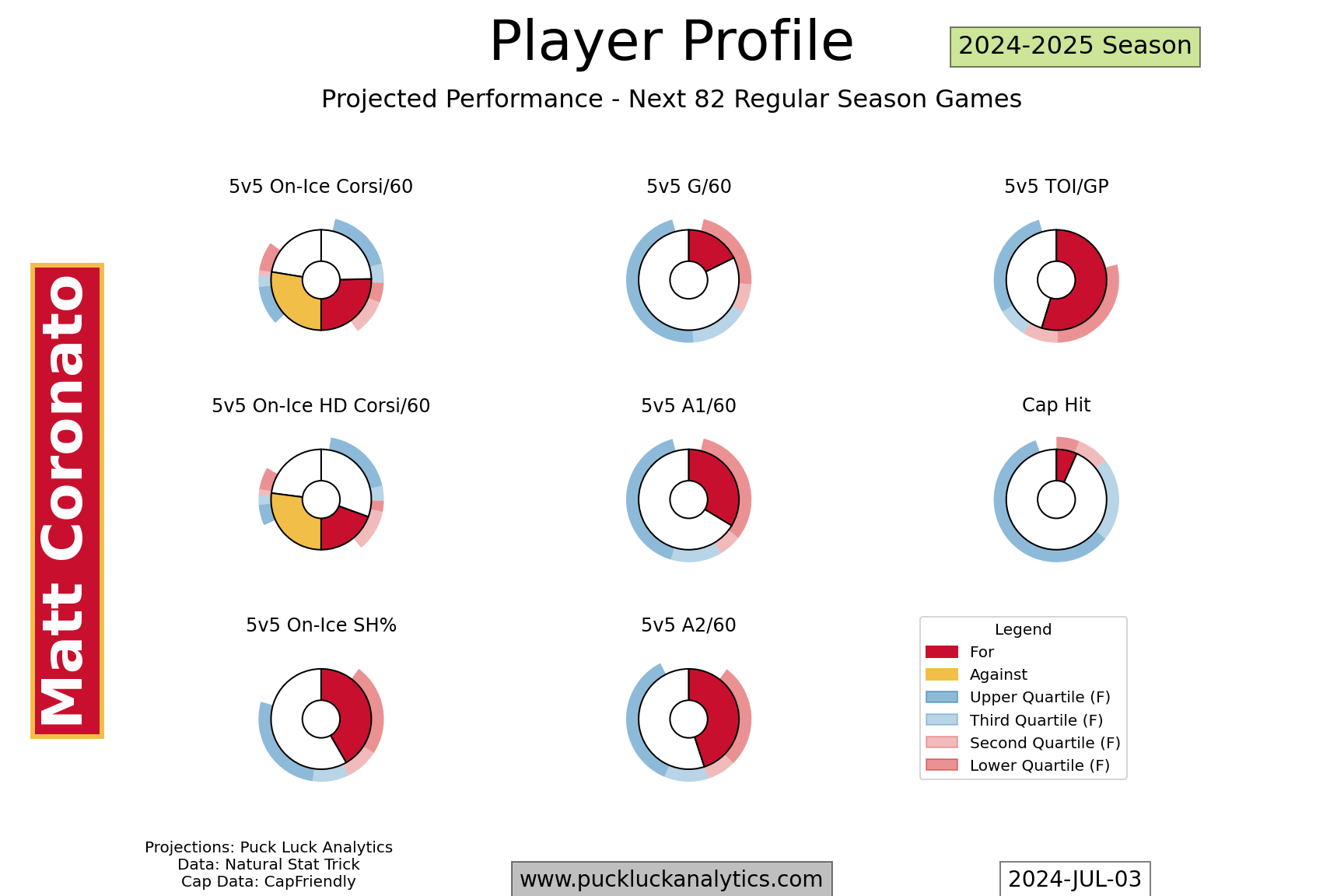

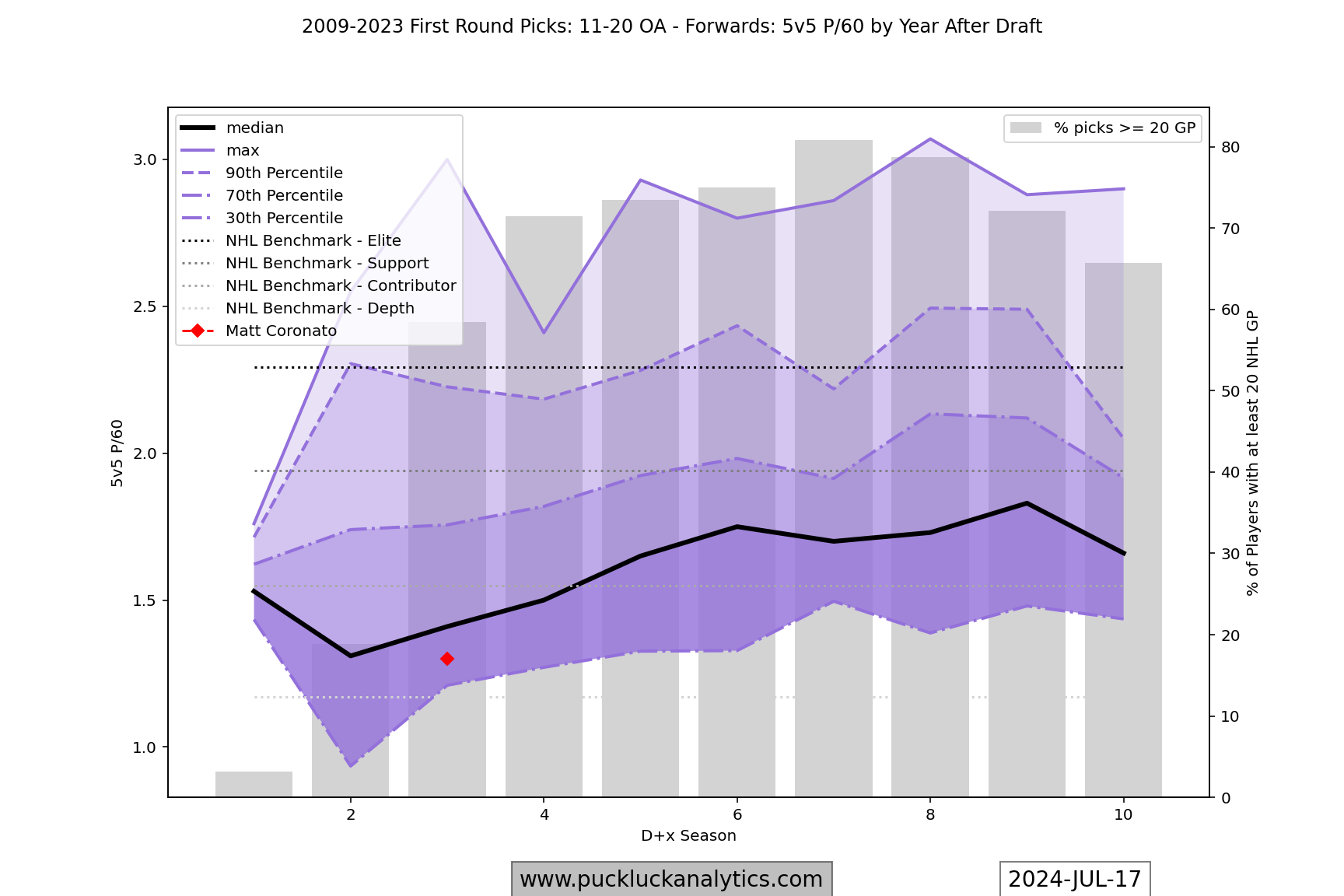
F – Mikael Backlund (35 / $4.5M / 2Y): Backlund was named captain last season after signing a 2 year extension that will take him to age 36. With a long runway for the team to get back to contending, he’ll have to play into his 40s to see it through. If he wants to chase a cup, trading him at the 2026 deadline would allow that and it would help the Flames recoup some assets at the same time. If he wants to play out his career in Calgary, he can be signed to a short term deal(s) to do so as a mentor for the primary cohort.
D – Rasmus Andersson (27 / $4.55M / 2Y): In his mid prime, Andersson is a good piece that many contenders would likely covet. His very reasonable cap hit makes him even more of a target. With the right side of the defense already filled out in our long term plan, it makes sense to get something for Andersson before he hits UFA in 2026. He’s our top 2026 deadline trade piece.
D – Daniil Miromanov (27 / $1.25M / 2Y): Miromanov was labeled as a prospect by some when he was traded to Calgary as part of the Noah Hanifin deal with Vegas. He’s 27 though, squarely in his prime, and he’s only played 49 NHL games in his career. He is 6’4″ and shoots right. That’s got 2026 deadline potential written all over it if the Flames can feature him with decent results until then.
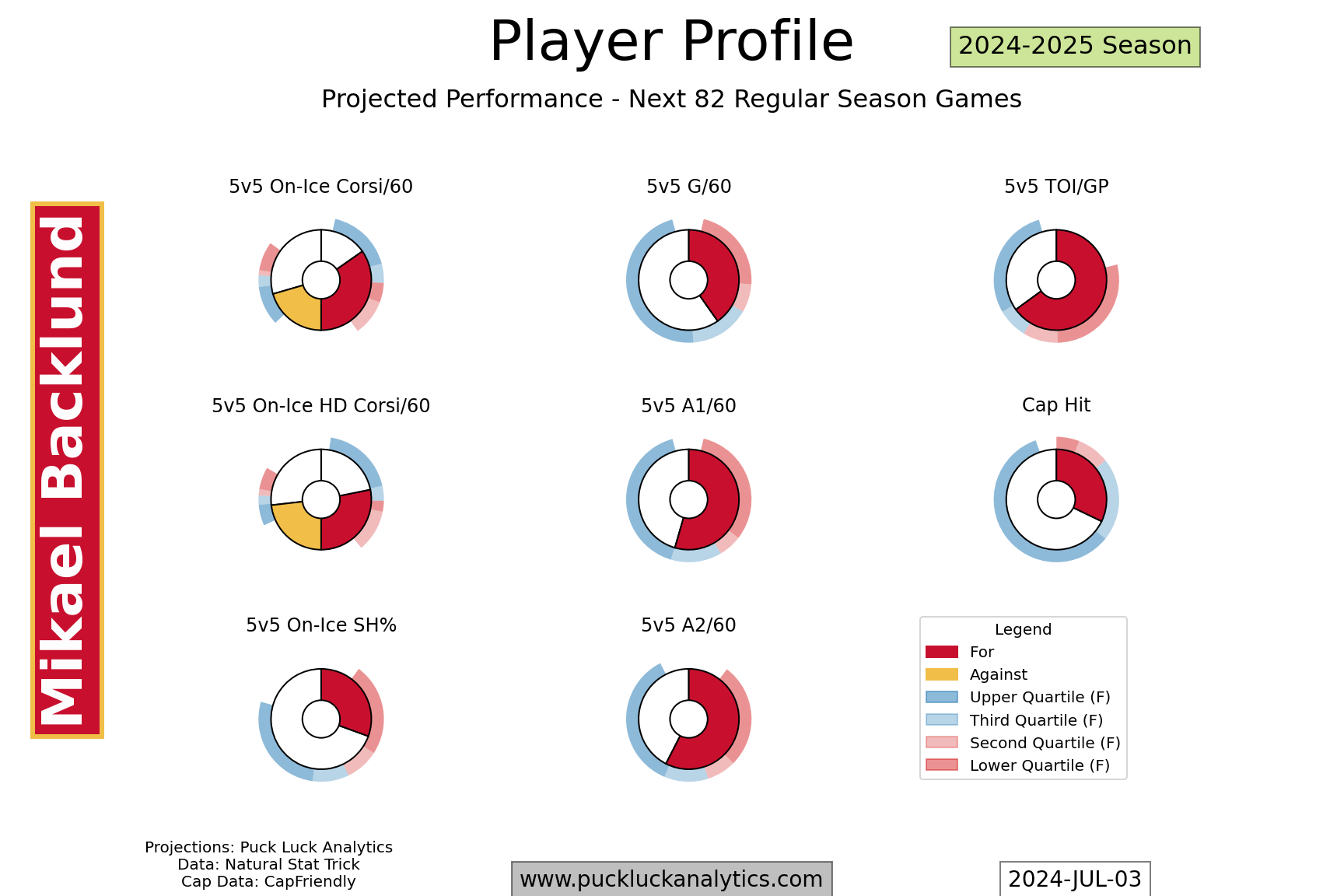
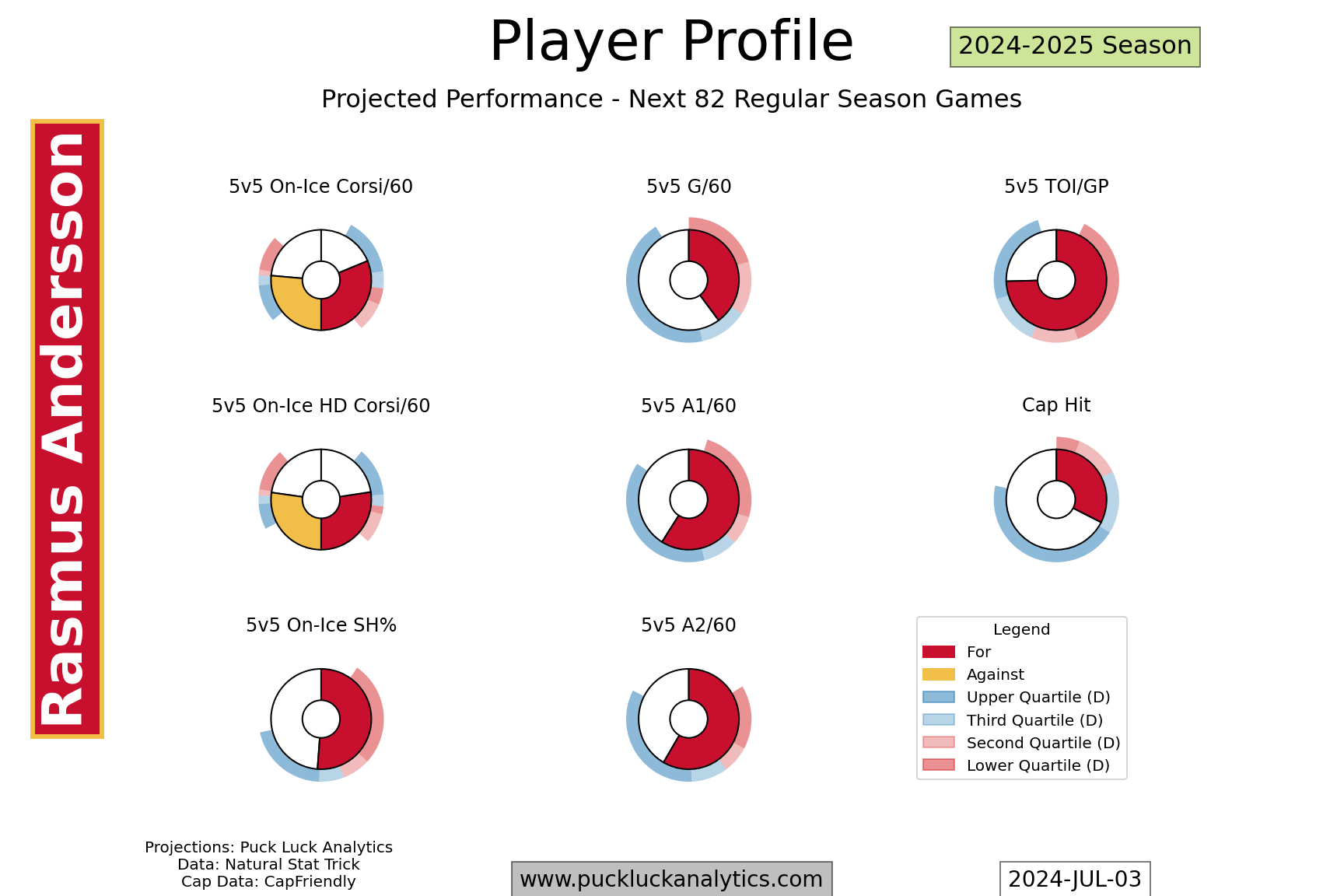
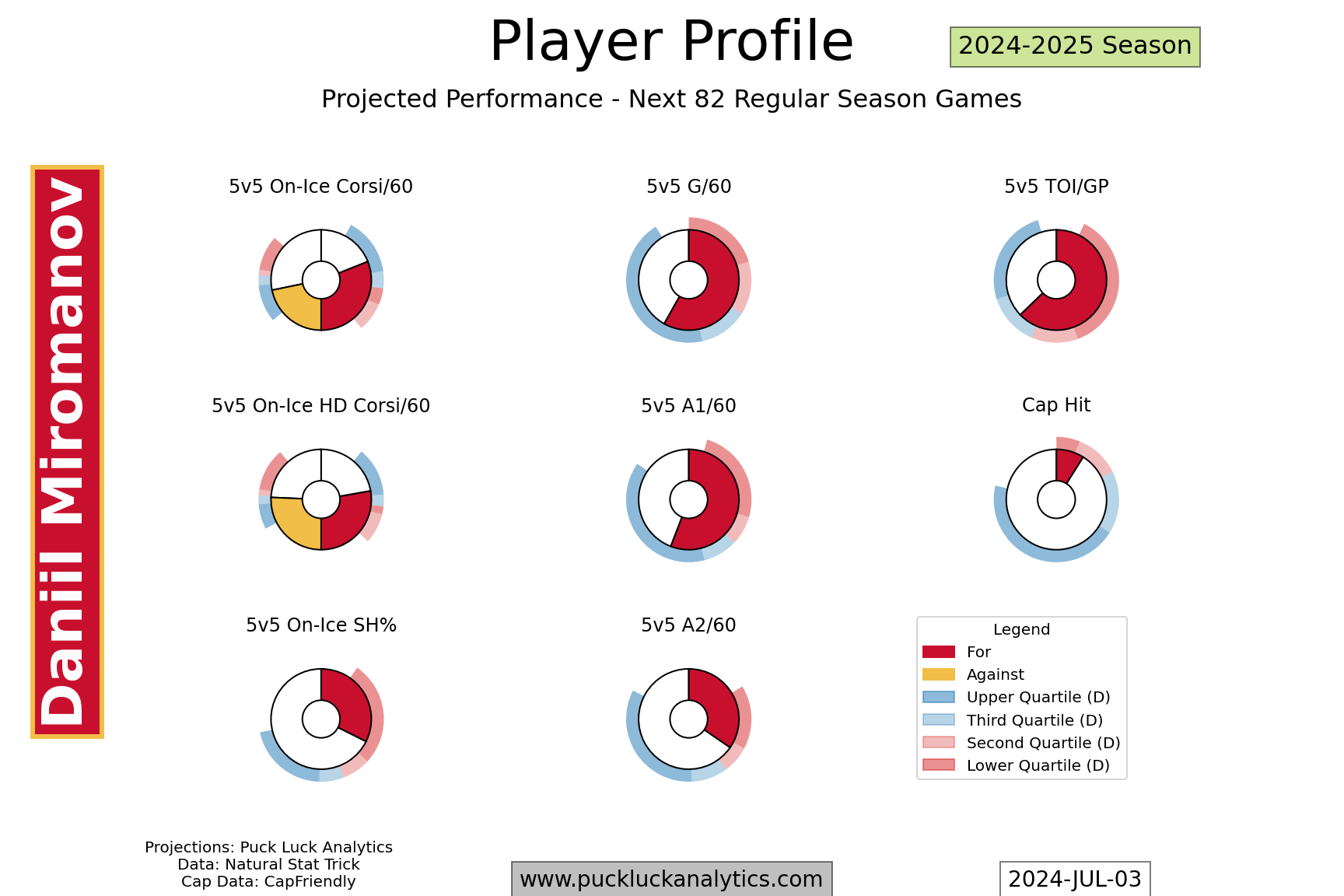
F – Blake Coleman (32 / $4.9M / 3Y): Coleman is a steady, play driving forward. With three years left on his deal, he seems like a good candidate to keep around as a veteran mentor for the short term. He’ll be in his late 30s by the time the target contention window starts though, so trading him at some point is a good option to add some future assets and open a roster spot for the contention cohort. The 2027 deadline may be the opportune time.
F – Nazem Kadri (33 / $7.0M / 5Y): A cup champion with the Avalanche in 2022, Kadri seemed to embrace the role of mentor to the Flames kids as last season wore on. He’ll be nearing 40 by the time the roster is ready to contend though so he’s another veteran the Flames should plan to move before the contention window opens. With a big cap hit attached, waiting until the last year or two of his deal is probably the most realistic timeline.
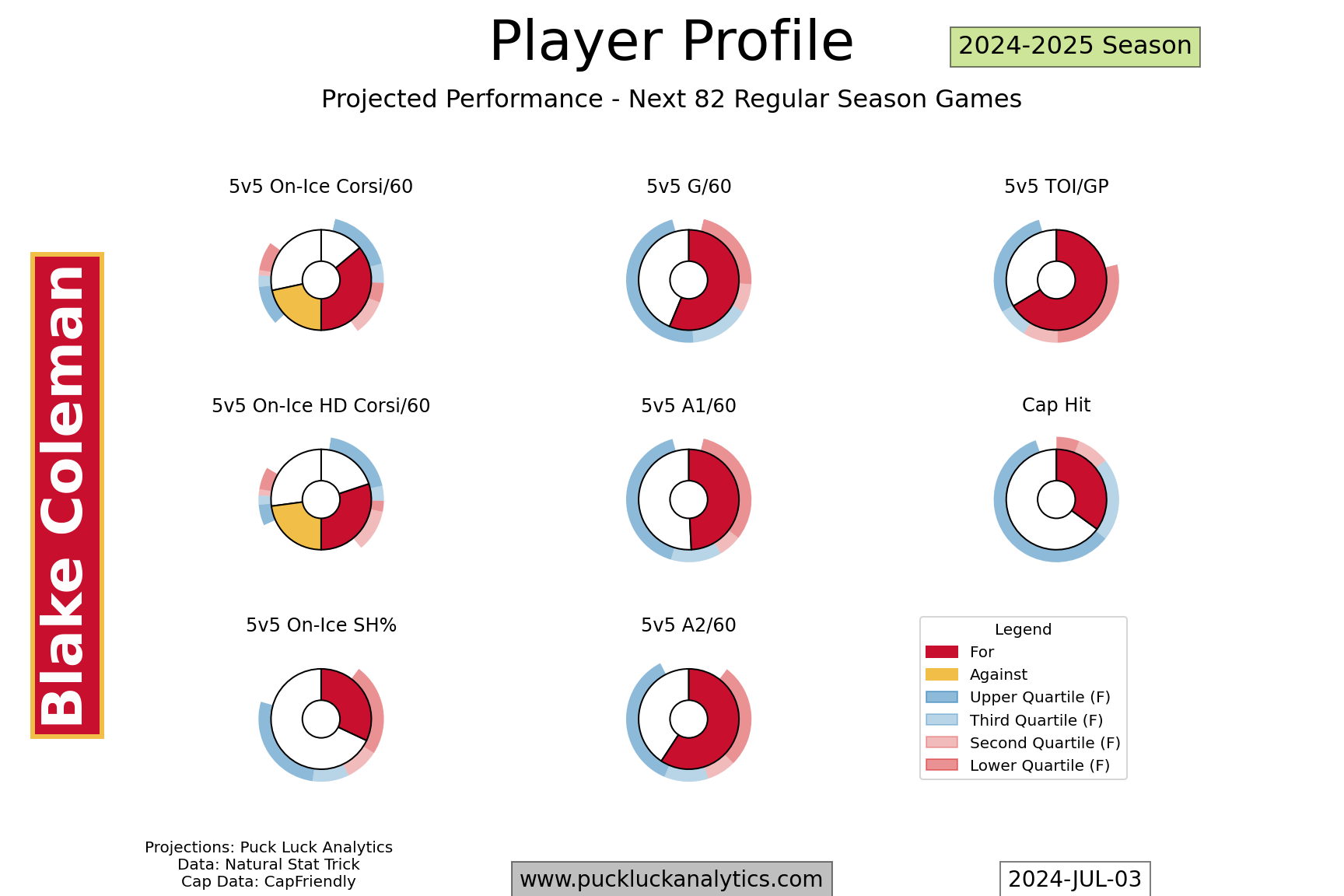
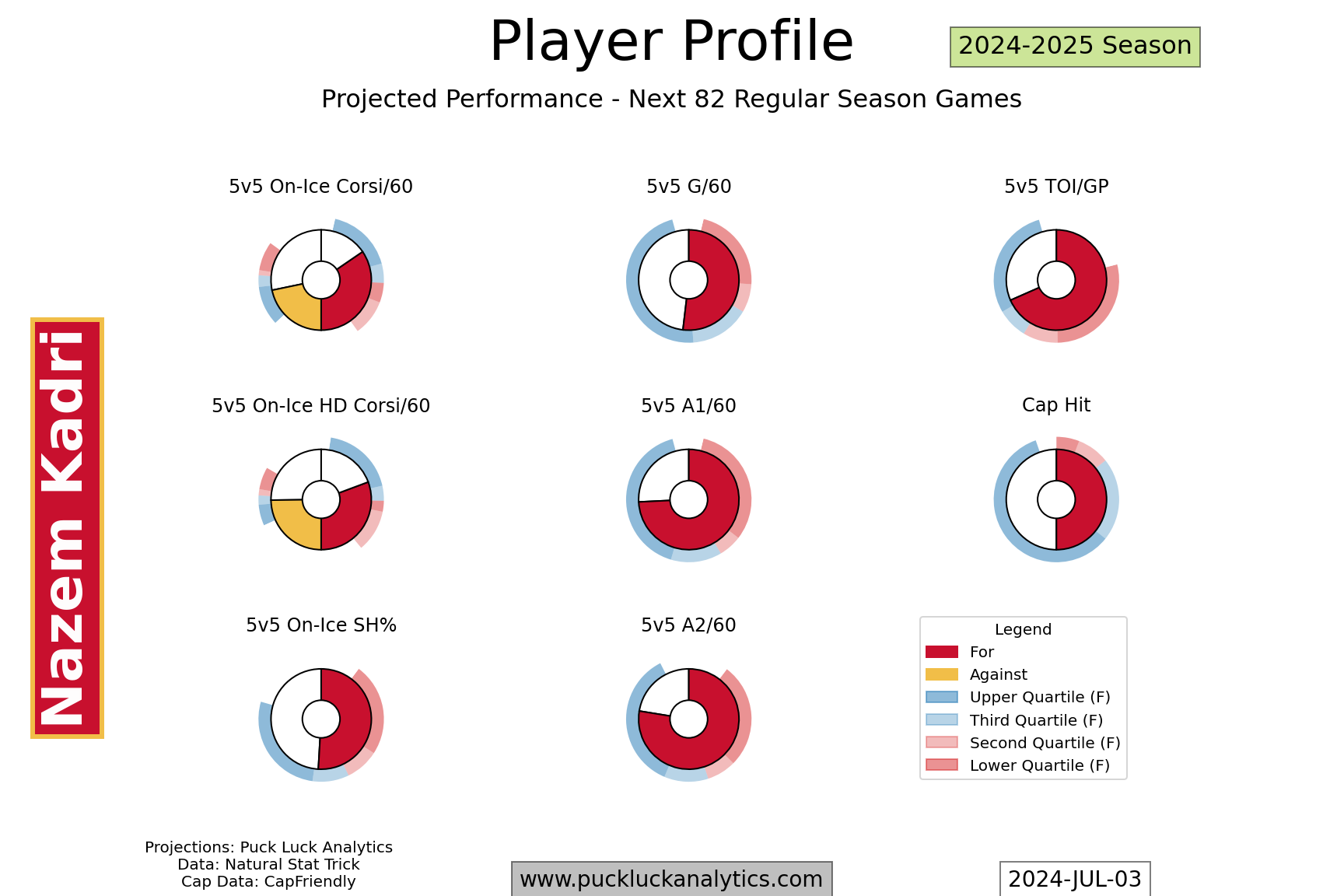
F – Jonathan Huberdeau (31 / $10.5M / 7Y): It’s been tough sledding in Calgary for Huberdeau, in large part due to some lofty expectations after the Flames 2022 blockbuster trade with the Panthers and the subsequent $84 million contract extension. The 6-8 year timeframe to enter a contention window aligns nicely with the remaining term on his deal, with his cap hit set to expire on the same timeline. If there’s a deal to be had to offload his contract anytime between now and then, it’s may be worth pulling the trigger. In the meantime, he’ll help the Flames get to the cap floor while the roster takes shape. We should be wary of is retention or a buyout near the end of the deal. That may be worthwhile, but it may also be a hindrance to the cap for the contention window. We should also be wary of paying a big price in future assets to get rid of his contract, particularly future assets from our primary contention cohort.
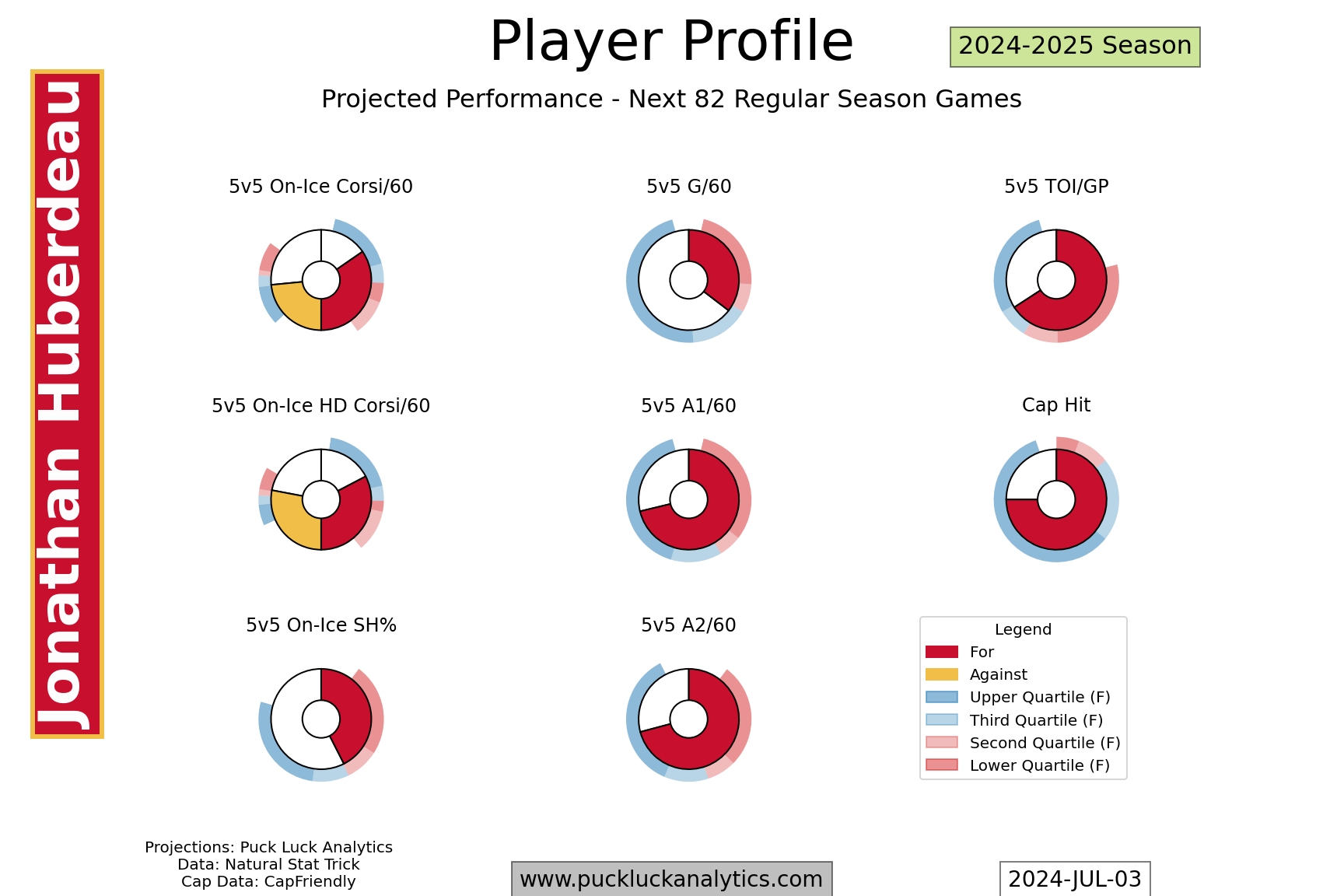
The rest of the current roster are bit players in the long term picture. We can consider them for short term extensions to fill holes in the NHL roster while the long term plan takes shape but we can replace them with external options as well.
F – Kevin Rooney (31 / $1.3M / 1Y): Rooney has been a fringe NHLer for the Flames the past couple of seasons and a one year deal this summer extends his presence.
F – Ryan Lomberg (29 / $2.0M / 2Y): Fresh off a Stanley Cup victory with the Florida Panthers, Lomberg returned to his NHL roots by signing a 2 year pact with the Flames this summer. Fun for the fans but there’s not much there for long term strategy.
D – Kevin Bahl (24 / $1.05M / 1Y): A capable NHL defenseman, Bahl will help buy time for the Flames defense prospects to develop but he’s not likely a key part of the plan moving forward.
D – Jake Bean (26 / $1.75M / 2Y): Bean signed a 2 year deal with his hometown team this summer. At age 26, he’s in his prime and is likely best suited to hold down the fort while the Flames prospects percolate at lower levels.
D – Brayden Pachal (25 / $775k / 1Y): Another bit player in the plan, Pachal was claimed off waivers by the Flames last season.
G – Dan Vladar (27 / $2.2M / 1Y): The Flames backup for the past couple of seasons, Vladar has one year left on his deal.
Trade Targets
We’ve identified a number of players we’d like to trade over the next few seasons, but we haven’t yet identified what we want to receive in return. There are a few priorities we can focus on:
2025 and 2026 Draft Picks: We identified that the primary contention cohort is short on forward options. We’d like to pick often and early in those two drafts to round out the cohort.
Prospects from the 2023 and 2024 Drafts with Elite Potential: Similar to the draft picks above, these prospects fall in our primary contention cohort. Prospects are a game a probabilities and adding more options that have potential to fill our needs improves the odds of our long term plan succeeding.
Left Defense with Elite Tier Potential: The biggest hole in our contention roster is at the top pair left defenseman. We’d like a second Elite Tier defenseman, but a Support Tier Dman may be acceptable. Ideally, the target should be under age 25 now so they are still near their prime when our contention cohort hits theirs.
2031-2034 Draft Picks: That’s a long time from now. It’s not a priority in the short term, but this is the group we want to build the next cohort around that will eventually transition in to extend the contention window.
Calgary Flames Roster Roadmap Summary




